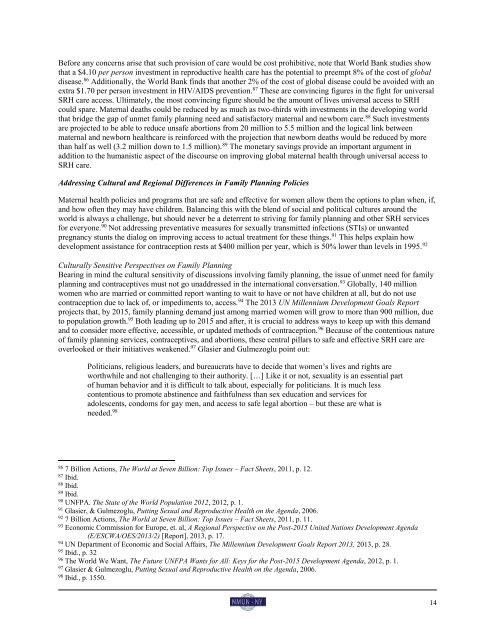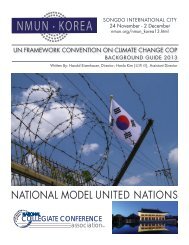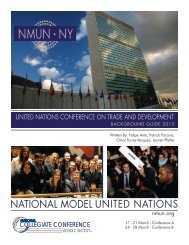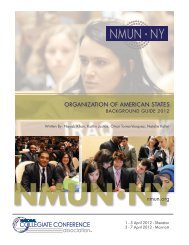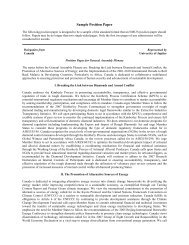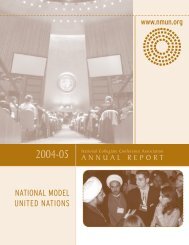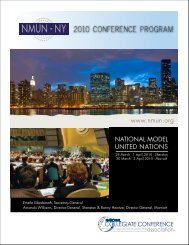UNFPA Background Guide - National Model United Nations
UNFPA Background Guide - National Model United Nations
UNFPA Background Guide - National Model United Nations
Create successful ePaper yourself
Turn your PDF publications into a flip-book with our unique Google optimized e-Paper software.
Before any concerns arise that such provision of care would be cost prohibitive, note that World Bank studies show<br />
that a $4.10 per person investment in reproductive health care has the potential to preempt 8% of the cost of global<br />
disease. 86 Additionally, the World Bank finds that another 2% of the cost of global disease could be avoided with an<br />
extra $1.70 per person investment in HIV/AIDS prevention. 87 These are convincing figures in the fight for universal<br />
SRH care access. Ultimately, the most convincing figure should be the amount of lives universal access to SRH<br />
could spare. Maternal deaths could be reduced by as much as two-thirds with investments in the developing world<br />
that bridge the gap of unmet family planning need and satisfactory maternal and newborn care. 88 Such investments<br />
are projected to be able to reduce unsafe abortions from 20 million to 5.5 million and the logical link between<br />
maternal and newborn healthcare is reinforced with the projection that newborn deaths would be reduced by more<br />
than half as well (3.2 million down to 1.5 million). 89 The monetary savings provide an important argument in<br />
addition to the humanistic aspect of the discourse on improving global maternal health through universal access to<br />
SRH care.<br />
Addressing Cultural and Regional Differences in Family Planning Policies<br />
Maternal health policies and programs that are safe and effective for women allow them the options to plan when, if,<br />
and how often they may have children. Balancing this with the blend of social and political cultures around the<br />
world is always a challenge, but should never be a deterrent to striving for family planning and other SRH services<br />
for everyone. 90 Not addressing preventative measures for sexually transmitted infections (STIs) or unwanted<br />
pregnancy stunts the dialog on improving access to actual treatment for these things. 91 This helps explain how<br />
development assistance for contraception rests at $400 million per year, which is 50% lower than levels in 1995. 92<br />
Culturally Sensitive Perspectives on Family Planning<br />
Bearing in mind the cultural sensitivity of discussions involving family planning, the issue of unmet need for family<br />
planning and contraceptives must not go unaddressed in the international conversation. 93 Globally, 140 million<br />
women who are married or committed report wanting to wait to have or not have children at all, but do not use<br />
contraception due to lack of, or impediments to, access. 94 The 2013 UN Millennium Development Goals Report<br />
projects that, by 2015, family planning demand just among married women will grow to more than 900 million, due<br />
to population growth. 95 Both leading up to 2015 and after, it is crucial to address ways to keep up with this demand<br />
and to consider more effective, accessible, or updated methods of contraception. 96 Because of the contentious nature<br />
of family planning services, contraceptives, and abortions, these central pillars to safe and effective SRH care are<br />
overlooked or their initiatives weakened. 97 Glasier and Gulmezoglu point out:<br />
Politicians, religious leaders, and bureaucrats have to decide that women’s lives and rights are<br />
worthwhile and not challenging to their authority. […] Like it or not, sexuality is an essential part<br />
of human behavior and it is difficult to talk about, especially for politicians. It is much less<br />
contentious to promote abstinence and faithfulness than sex education and services for<br />
adolescents, condoms for gay men, and access to safe legal abortion – but these are what is<br />
needed. 98<br />
86<br />
7 Billion Actions, The World at Seven Billion: Top Issues – Fact Sheets, 2011, p. 12.<br />
87<br />
Ibid.<br />
88<br />
Ibid.<br />
89<br />
Ibid.<br />
90<br />
<strong>UNFPA</strong>. The State of the World Population 2012, 2012, p. 1.<br />
91<br />
Glasier, & Gulmezoglu, Putting Sexual and Reproductive Health on the Agenda, 2006.<br />
92<br />
7 Billion Actions, The World at Seven Billion: Top Issues – Fact Sheets, 2011, p. 11.<br />
93<br />
Economic Commission for Europe, et. al, A Regional Perspective on the Post-2015 <strong>United</strong> <strong>Nations</strong> Development Agenda<br />
(E/ESCWA/OES/2013/2) [Report], 2013, p. 17.<br />
94<br />
UN Department of Economic and Social Affairs, The Millennium Development Goals Report 2013, 2013, p. 28.<br />
95<br />
Ibid., p. 32<br />
96<br />
The World We Want, The Future <strong>UNFPA</strong> Wants for All: Keys for the Post-2015 Development Agenda, 2012, p. 1.<br />
97<br />
Glasier & Gulmezoglu, Putting Sexual and Reproductive Health on the Agenda, 2006.<br />
98<br />
Ibid., p. 1550.<br />
14


